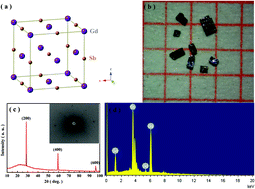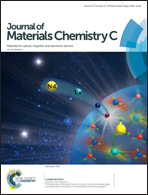Extremely large magnetoresistance in the antiferromagnetic semimetal GdSb
Abstract
Semimetals with extremely large magnetoresistance have attracted significant interest because of their possible nontrivial electronic structures, unusual transport properties, and also deep connections to high-energy physics. In this paper, we synthesize the GdSb single crystal and systematically characterize its crystal structure, magnetism, and electric transport properties. It is found that this compound crystallizes in the NaCl-type structure with a space group Fm![[3 with combining macron]](https://www.rsc.org/images/entities/char_0033_0304.gif) m and experiences an antiferromagnetic phase transition at 23.4 K. Electric transport measurements reveal that this compound is metallic, in which spin disorders induced a resistivity anomaly emerging around its magnetic transition temperature. Intriguingly, obvious resistivity plateaus are observed at low temperatures, when the compound is subjected to the external magnetic field, showing an extremely large magnetoresistance effect up to 12 100% at 2 K and 9 T. Through the Hall resistivity measurement and first-principles band structure calculations, GdSb is believed to be a multi-band and compensated semimetal, in which the total carrier concentrations of electrons and holes are almost comparable. The electron–hole compensation and ultrahigh mobility of GdSb can contribute to the large magnetoresistance in this compound.
m and experiences an antiferromagnetic phase transition at 23.4 K. Electric transport measurements reveal that this compound is metallic, in which spin disorders induced a resistivity anomaly emerging around its magnetic transition temperature. Intriguingly, obvious resistivity plateaus are observed at low temperatures, when the compound is subjected to the external magnetic field, showing an extremely large magnetoresistance effect up to 12 100% at 2 K and 9 T. Through the Hall resistivity measurement and first-principles band structure calculations, GdSb is believed to be a multi-band and compensated semimetal, in which the total carrier concentrations of electrons and holes are almost comparable. The electron–hole compensation and ultrahigh mobility of GdSb can contribute to the large magnetoresistance in this compound.



 Please wait while we load your content...
Please wait while we load your content...